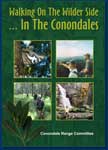Status of vegetation at the abandoned Agricola mine
Current status of the vegetation at the abandoned Agricola mine site, Conondale National Park
by Jason Weber
Rehabilitation Scientist, Abandoned Mines Unit, Dept of Natural Resources & Mines.
Date: 06/06/2016
The purpose of this article is to describe the current status of vegetation on the site of the abandoned Agricola gold mine within Conondale National Park. Approximately 20 years have elapsed since the site was subject to extensive remediation works commissioned by the State Government. Part of these remediation works involved detoxifying contaminated water, dewatering the open cut mine, applying lime / crushed marble for acid mine drainage control and installing / modifying clay containment cell caps covering the open cut mine and taillings dump. Sections of the site were subject to replanting and / or direct seeding with sclerophyllous and, to a lesser extent, rainforest plant species.
The site can be broken down into three broad areas. The containment cell caps covering the open cut mine and the taillings dam; the mine benches; and the vegetation surrounding the mine site. The vegetation on the containment cell caps over the open cut mine and taillings dam include a thick ground cover layer consisting of native raspberry (Rubus parvifolius) or bracken fern (Pteridium esculentum). There is a thin mid-story of native shrub species, Acacia irrorata as well as Eucalyptus, Allocasuarina some rainforest species saplings. The thin to medium canopy consists mainly of planted Eucalyptus and Allocasuarina trees with some Acacia (dead or dying back) trees.
Many of the originally planted black wattle (Acacia melanoxylon) trees have reached maturity and died. The fallen trunks increase the habitat complexity across the site. The planted Eucalyptus and Allocasuarina trees are growing well and appear to have self-seeded in areas. There are also scattered rainforest plant species saplings across the site. Some have been naturally recruited from the surrounding forest and some may have been planted. Planted bunya pine (Araucaria bidwillii) saplings can be found across the site.
The vegetation on the former mines’ benches consists of sclerophyllous and rainforest plant species. The lushness of the vegetation depends on the bench aspect and the amount of soil present. In some of the more shaded areas of the benches, ferns grow on the rocks and trees pop up in gaps between the rocks. In the more exposed and less stable areas, the vegetation can be very open and consist of low ground-covering ferns and other vegetation.
The vegetation surrounding the mine site is in a very healthy condition and varies from sclerophyllous vegetation at the top of the site to rainforest vegetation that abuts Booloumba Creek. There appears to be minimal edge effects caused by the mine on the adjacent forest (no vine blanket etc) and in most areas the mine side access track marks the last visible impact of the mine on surrounding vegetation.
At this point in time, the main areas of concern are the bare areas on top of the tailllings dam containment cell cap. This area is extensively disturbed by feral pig and deer activity. Currently, a soil sampling project is underway to determine if the pigs are the cause of the bare areas or are symptoms of it. Pig damage is sporadic across the site. There is very little incursion by introduced plant species across the site and lantana was not been detected during recent site investigations. There is a small population of non-local cypress (Callitris sp.) trees that were probably introduced with imported mulch some two decades ago. These will likely be subject to a control program in the near future.
The Abandoned Mines Unit, Southern Region is developing a site management plan to address any areas of concern identified by ongoing monitoring.



